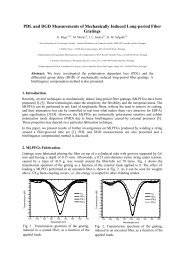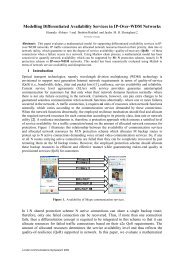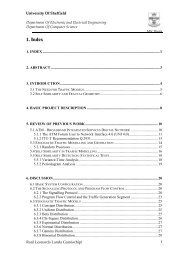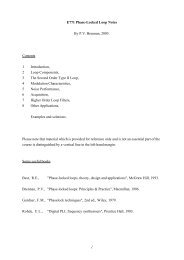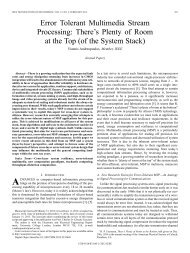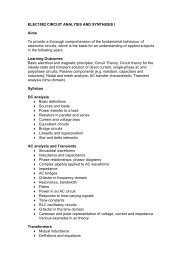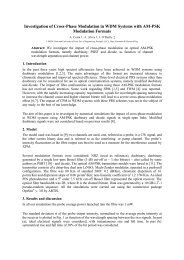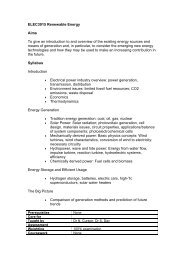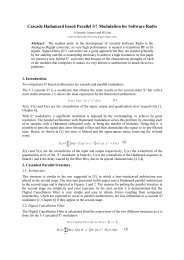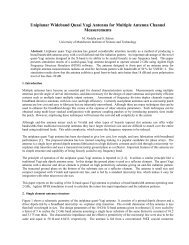full programme - UCL Department of Electronic and Electrical ...
full programme - UCL Department of Electronic and Electrical ...
full programme - UCL Department of Electronic and Electrical ...
You also want an ePaper? Increase the reach of your titles
YUMPU automatically turns print PDFs into web optimized ePapers that Google loves.
DEPARTMENT OF ELECTRONIC ANDELECTRICAL ENGINEERING125 YEARS1885-2010The Mildner Memorial Lecture 2010 <strong>and</strong> ResearchPoster Presentation Friday 25th June 2010
Programme2.00pm Research Poster SessionNorth Cloisters, Wilkins Building4.00pm Perspectives on <strong>Electronic</strong> EngineeringGustave Tuck Lecture Theatre, Wilkins Building5.00pm ReceptionSouth Cloisters, Wilkins Building5.30pm Award <strong>of</strong> Student PrizesThe Cullen Prize for the Best Student PosterThe Fabrizio Lombardi Prize for theBest Recently Graduated PhDFollowed byThe Mildner Memorial Lecture 2010Pr<strong>of</strong>. Lord Alec Broers FREng, FRS, Kt DL“Engineering, Science <strong>and</strong> the Economy ”J.Z. Young Lecture Theatre, Anatomy Building2
Welcome MessageDear GuestIt is my pleasure to welcome you to this year's Mildner Lecture <strong>and</strong> associated events. Thisyear marks the 125th anniversary <strong>of</strong> the founding <strong>of</strong> the <strong>Department</strong>, the first <strong>Department</strong><strong>of</strong> <strong>Electrical</strong> Engineering in Engl<strong>and</strong>. We started our year <strong>of</strong> celebrations with the formalopening <strong>of</strong> the <strong>Department</strong>'s new Molecular Beam Epitaxy Facility by HRH The PrincessRoyal in January. Last week we celebrated the achievements <strong>of</strong> 2009 Nobel LaureateCharles Kao, with the award to him <strong>of</strong> a <strong>UCL</strong> Honorary Degree. Charles Kao, who studiedwith former Head <strong>of</strong> <strong>Department</strong>, Harold Barlow, is the first Nobel Prize winner to beassociated with the <strong>Department</strong>.Today, we celebrate the current research <strong>of</strong> the <strong>Department</strong> with a Research Poster Display.The research work carried out by both postgraduate <strong>and</strong> post-doctoral researchers is a vitalelement <strong>of</strong> all leading research departments. Today you will see presentations <strong>of</strong> the work <strong>of</strong>our staff, PhD, <strong>and</strong> EngD researchers.Following the Research Poster Display there is a special anniversary event, "Perspectives on<strong>Electronic</strong> Engineering", presented by our former Heads <strong>of</strong> <strong>Department</strong> .The Mildner Memorial Lecture is held biennially (alternate years with the Barlow MemorialLecture) in memory <strong>of</strong> Raymond Charles Mildner [1907-1977] who, having obtained a BSc(Eng) [1927] <strong>and</strong> an MSc (Eng) [1931] from <strong>UCL</strong>, made major contributions to thetechnology <strong>of</strong> power <strong>and</strong> communication cables, his work spanning an interdisciplinaryspectrum from electromagnetic theory through to materials science. In 1969 he wasempowered by the Dow Chemical Company to nominate the recipient <strong>of</strong> a $2,500 gift. Henominated the <strong>Department</strong> <strong>of</strong> <strong>Electronic</strong> <strong>and</strong> <strong>Electrical</strong> Engineering at <strong>UCL</strong> <strong>and</strong> the thenHead <strong>of</strong> <strong>Department</strong>, Pr<strong>of</strong>essor Alex Cullen FRS, instituted the biennial Mildner Lecture.This year we are delighted to welcome distinguished electronic engineer, Reith Lecturer <strong>and</strong>former Vice-Chancellor <strong>of</strong> the University <strong>of</strong> Cambridge, Pr<strong>of</strong>essor Lord Alec BroersFREng, FRS, Kt DL to give the 2010 Mildner Lecture.I hope that you will enjoy your visit to <strong>UCL</strong> <strong>and</strong> that it will lead to increased collaborationin the future.Pr<strong>of</strong>essor Alwyn SeedsHead <strong>of</strong> <strong>Department</strong> 3
The Mildner Memorial Lecture 2010:“Engineering, Science <strong>and</strong> the Economy”Pr<strong>of</strong>. Lord Alec Broers FREng, FRS, Kt DLAbstract: Climbing out <strong>of</strong> the cavernous economic hole that we havestumbled into is going to require more than the usual combination <strong>of</strong>growth <strong>and</strong> inflation; even if we were to allow another 2008-style massivedevaluation <strong>of</strong> the Pound. It is going to require engineering <strong>and</strong> science toprovide both a genuine increase in GDP per person, through therestoration <strong>of</strong> competitiveness across the broad spectrum <strong>of</strong> our industry,<strong>and</strong> an increase in the efficiency <strong>of</strong> our public services, especially health,transport <strong>and</strong> energy. Even if these challenges are met, it will probably stillbe necessary to cut public expenditure, but hope<strong>full</strong>y by a tolerableamount. Without the increases in GDP <strong>and</strong> efficiency, public expenditurewill have to be cut 25-30% with the inevitable pain <strong>and</strong> social discomfort.To bring public debt below 50% <strong>of</strong> GDP <strong>and</strong> the annual deficit below 4%,will require more than £200 billion per year, or more than ten times thesums discussed in the election campaign.This lecture will examine the challenges facing engineers <strong>and</strong> scientists inthe decades ahead if we are to achieve what will be necessary to repair oureconomy. The gr<strong>and</strong> challenges for engineering identified by the USNational Academy <strong>of</strong> Engineering, at the request <strong>of</strong> the US NationalAcademy <strong>of</strong> Science, will be taken as a starting point.4
The 2010 Mildner Memorial LecturerLord Broers FREng FRS is an engineer who has specialised in the design<strong>and</strong> use <strong>of</strong> electron microscopes <strong>and</strong> in the fabrication <strong>of</strong> microelectronicchips. He studied at Melbourne <strong>and</strong> Cambridge Universities <strong>and</strong> was aresearcher at IBM’s R & D laboratories in New York for nineteen yearswhere he fabricated the first man made devices with nanometredimensions. He was appointed IBM Fellow <strong>and</strong> eventually heldresponsibility for the advanced development <strong>of</strong> IBM’s microchips. Hereturned to Cambridge in 1984 where he extended the technology <strong>of</strong>miniaturisation to the atomic scale. He subsequently became Head <strong>of</strong> the<strong>Department</strong> <strong>of</strong> Engineering, Master <strong>of</strong> Churchill College <strong>and</strong> Vice-Chancellor <strong>of</strong> the University. He has been a non-executive director <strong>of</strong> anumber <strong>of</strong> companies including Lucas Industries, Vodafone <strong>and</strong> severalhigh technology start-ups. He became President <strong>of</strong> the Royal Academy <strong>of</strong>Engineering in 2000 <strong>and</strong> a Cross-bench Member <strong>of</strong> the House <strong>of</strong> Lords in2004. He chaired the Lord’s Science <strong>and</strong> Technology Committee from2004 until 2007 <strong>and</strong> is presently a member <strong>of</strong> the Committee. He isChairman <strong>of</strong> the Board <strong>of</strong> the Diamond Light Source, Chairman <strong>of</strong> TheBioNano Centre, Fellow <strong>of</strong> the National Academies <strong>of</strong> Engineering <strong>of</strong>the USA, China <strong>and</strong> Australia, a member <strong>of</strong> the Bosch GroupInternational Advisory Committee, <strong>and</strong> a Trustee <strong>of</strong> the British Museum<strong>and</strong> the American University <strong>of</strong> Sharjah.5
Research Poster SessionCommunications <strong>and</strong> Information Systems Group (CISG)CISG carries out theoretical <strong>and</strong> experimental research into all layers<strong>of</strong> communication systems including information security <strong>and</strong> retrieval, IP<strong>and</strong> multimedia networking, network <strong>and</strong> service management, wireless<strong>and</strong> optical access networks.IDCISG1CISG2CISG3CISG4CISG5CISG6CISG7CISG8CISG9CISG10CISG11CISG12CISG13CISG14CISG15CISG16CISG17CISG18CISG19CISG20CISG21CISG22Poster titleFuture Comms Architecture: Open-access connectivity (Wired <strong>and</strong> Wireless)VIGILANT: "Situation-Aware" Quality <strong>of</strong> Information Interest Groups forWireless Sensor Network Surveillance ApplicationsRationale for a Mobility Management Layer in Communications DesignsSensor Networks: Enabling the Sensor Web <strong>and</strong> Facilitating Data FusionThe Management <strong>of</strong> Communication Infrastructure ProjectsExposure to Electromagnetic Fields from Wireless Computer Networks (Wi-Fi)FPGA Implementation <strong>of</strong> Simple Digital Spectrally Efficient FDM TransmitterClock Management in Large Scale Digital Systems ArchitectureA Robust FIR Filter with In Situ Error DetectionFuture Comms Architecture: Open-access connectivity (Wired <strong>and</strong> Wireless)Future Backhaul Access Bottleneck StudyModelling MAC Layer Performance in Next Generation Wireless NetworksImproving performance <strong>of</strong> Networked GamesReinforcement Learning based Routing for Dynamic wireless NetworksAll-Optical Processing in Next Generation Access NetworksS<strong>of</strong>tware Designs Of Image Processing Tasks With Incremental Refinement OfComputationEnvironment Aware WSN in Industry LocationTwo Photon Microscopy: Signal Synthesis for Acousto-Optic Lens ControlPhysical layer security for the broadcast channelOFDMA-Passive Optical Networks (OFDMA-PON)Simple Digital Transmitters for Spectrally Efficient FDM (SEFDM) SystemBehavioural Markers <strong>of</strong> User Development6
Research Poster Session<strong>Electronic</strong> Materials <strong>and</strong> Devices Group (EMDG)EMDG carries out research into advanced electronic materials <strong>and</strong> theirproperties for applications in such diverse areas as energy, healthcare <strong>and</strong>IT.IDEMDG1EMDG2EMDG3EMDG4EMDG5EMDG6EMDG7EMDG8EMDG9EMDG10EMDG11EMDG12EMDG13EMDG14EMDG15Poster titleRecovery <strong>of</strong> nanocrystalline silicon TFT after light-bias stress<strong>Electronic</strong> properties <strong>of</strong> nanodiamondsRecovery <strong>of</strong> data from damaged electronic memory devicesHigh Performance Pentacene Thin Film Transistors on Silicon NitrideDelta-doped diamond structures for high performance electronicsLight-bias stress in metal oxide thin film transistorsMetallic <strong>and</strong> semiconductor nanoparticles in polymer nan<strong>of</strong>ibers forphotonic <strong>and</strong> electronic applicationsRate equation modelling <strong>of</strong> Erbium doped Silicon NanocrystalsHigh performance single crystal diamond radiation detectorsNanodiamond MEMS sensorsNanodiamonds for neuronal cell attachment, growth <strong>and</strong> network formationCarbon nanotube-diamond heterostructuresDiamond <strong>Electronic</strong>s <strong>and</strong> Nanotechnology Group PosterNanoelectronic DevicesIndividual Bi dopants in silicon7
Research Poster SessionOptical Networks Group (ONG)ONG carries out fundamental analysis <strong>and</strong> design <strong>of</strong> optical networks, highspeedtransmission, <strong>and</strong> techniques for optical, electronic <strong>and</strong> quantumsignal processing.ID Poster titleONG1 Development <strong>of</strong> an ultra-stable laser in the 1.5 micron b<strong>and</strong> for opticalfrequency transfer over optical fibreONG2 Multi-Level Modulation Formats in Optical CommunicationONG3 Carrier Recovery in a Digital Coherent ReceiverONG4 Digital Compensation <strong>of</strong> Fibre NonlinearitiesONG5 Impact <strong>of</strong> network traffic on the performance <strong>of</strong> dynamic optical networksONG6 Surface plasmon polaritonic crystal polarisation demultiplexer for 4-level polarisation-shift-keyingONG7 Real-time Optical OFDMONG8 DSP-based crosstalk cancellation in WDM interconnectsONG9 High-speed (>40Gbit/s) optical fibre communications usingOTDM techniques <strong>and</strong> advanced modulation formatsONG10 Optimising the FEC Overhead in a 100GbE PDM-QPSK DigitalCoherent TransceiverPhotonics Group(PG)PG carries out vertically integrated photonics research, from device design<strong>and</strong> fabrication to physical layer systems design <strong>and</strong> evaluation.ID8Poster titlePG1 Combining miniaturized THz sources with magnetic fields: A Pro<strong>of</strong> <strong>of</strong> ConceptPG2 Liquid Crystal axiconPG3 Next generation laser pumping / amplification systemsPG4 Tunable liquid crystal photonic b<strong>and</strong> gaps for h<strong>and</strong> held display applicationsPG5 Development <strong>of</strong> automatic temperature compensation s<strong>of</strong>tware forOFS data
Research Poster SessionPhotonics Group(PG)IDPG6PG7PG8PG9Poster titleNext Generation Optical Access NetworksThe Characterisation <strong>of</strong> a Pulse Controlled High Power MOPA Based YbFibre Laser in Micro Materials Processing OperationsBlocking In Optical Packet Switch ArchitecturesModelling <strong>of</strong> THz waveguides <strong>and</strong> their characterisation with near field microscopyPG10 Digital Art Capture Image ProcessingPG11 Liquid Crystal based Microwave DevicesPG12 Non-linear scattering <strong>of</strong> femtosecond pulses by 2D plasmonic nano-cavities.PG13 Ultrafast InP based Photoconductor capable <strong>of</strong> Picosecond SwitchingPG14 Ultra-Fast Photodetectors for Continuous Wave Terahertz GenerationPG15 Third Generation Photovoltaics: Intermediate B<strong>and</strong> Quantum Dot Solar CellsPG16 Photolithographically Manufacured crylate Multimode Optical WaveguideTrenlation <strong>and</strong> Rotation Misalignment Tolerances.PG17 Propagation Characteristics <strong>of</strong> Circular <strong>and</strong> Rectangular Waveguides with anArbitrary Index Pr<strong>of</strong>ilePG18 Silicon Photonics: III-V Quantum Dots Lasers on SiliconPG19 A Fast FPGA Implementation <strong>of</strong> Optical Distributed SensingPG20 FTSE 100 Returns <strong>and</strong> Volatility estimation using Higher Order Neural NetworksPG20 HELIUM3D - High Efficiency Laser Based Multi User Multi Modal 3D DisplayPG21 Integrated optical <strong>and</strong> electronic interconnect PCB ManufacturingPG22 Photonic Integration <strong>of</strong> Terahertz SourcesPG23 Homodyne Coherent Optical Receiver with High Tolerance to LaserLinewidthPG24 Photonic Techniques for Coherent Detection <strong>of</strong> THz SignalsPG25 Accurate Modelling <strong>of</strong> Defect Creation <strong>and</strong> ControlPG26 Demonstration <strong>of</strong> an Indoor Real-Time Location System with Optical FibreBackbone9
Research Poster SessionSensors, Systems <strong>and</strong> Circuits Group (SSCG)SSCG carries out research into intelligent sensor systems <strong>and</strong> mixed-signalICs, applying an innovative combination <strong>of</strong> sensors <strong>and</strong> signal processing.IDSSCG1SSCG2SSCG3SSCG4SSCG5SSCG6SSCG7SSCG8SSCG9Poster titleIsolation <strong>of</strong> the Zenneck Surface WaveMonostatic Coherent Radar Sea Clutter Doppler AnalysisMultifunction Radar Tracking ControlGrating lobe control in r<strong>and</strong>omised, sparsely-populated MIMO radararraysAdaptive, intelligent tracking <strong>of</strong> air targets using the CASA networkMicrostrip Antenna Array for Avalanche RadarAirborne Passive Bistatic RadarFMCW radar imaging <strong>of</strong> avalanche-like snow movementsGround Penetrating RadarSSCG10 Making Terahertz visibleSSCG11A Current-Steering Integrated Neural Stimulator with Field Shifting forDeep Brain StimulationSSCG12 Measurement <strong>of</strong> Bistatic Sea ClutterSSCG13 Target classification using ultrasound micro-Doppler signaturesSSCG14 Closed loop neural prosthesis for vestibular disorders10
Contact InformationThe postgraduate students, research fellows <strong>and</strong> academics will behappy to provide you with contact details <strong>of</strong> their own researchgroups. Links to all the <strong>Department</strong>’s research groups can befound on the web page:http:// www.ee.ucl.ac.uk/researchFor more general enquiries please contact:Dr Seb Savory<strong>Department</strong> <strong>of</strong> <strong>Electronic</strong> <strong>and</strong> <strong>Electrical</strong> EngineeringUniversity College LondonTorrington PlaceLondon WC1E 7JEE-mail:s.savory@ee.ucl.ac.ukTelephone: 020 7679 3995Fax: 020 7388 9325who will direct your enquiry to the appropriate individual.11
New for 2010: MSc in Telecommunicationswith BusinessThe “Telecoms with Business Programme” is an exciting new <strong>programme</strong>which is designed to address the market need for highly skilled technicalmanagers in the ICT <strong>and</strong> telecommunications industry that have a broadknowledge across both technology <strong>and</strong> business. This new <strong>programme</strong>exploits the established <strong>and</strong> high successful portfolio <strong>of</strong> telecommunicationsMSc modules run by the <strong>UCL</strong> <strong>Department</strong> <strong>of</strong> <strong>Electronic</strong> & <strong>Electrical</strong>Engineering (E&EE) in combination with four specially designed businessmodules to create a new MSc degree in Telecommunications with Business.These four business modules draw on the experience <strong>of</strong> leading expertsfrom Industry <strong>and</strong> academia in the area <strong>of</strong> business planning, financial <strong>and</strong>management accounting, regulation, marketing <strong>and</strong> product management.This course aims to provide the management tools <strong>and</strong> techniques <strong>of</strong> anMBA <strong>programme</strong> but with the focussed application to the specific industrythat an MSc can provide. It is aimed at both recent graduates <strong>and</strong> those withexperience who seek accelerated progression to senior management <strong>and</strong>technical positions <strong>and</strong> is also available as a part-time course over 2 years.For further details please contact msctwithb@ee.ucl.ac.uk.125 Years <strong>of</strong> <strong>Electronic</strong> &<strong>Electrical</strong> Engineering at <strong>UCL</strong>The logo, designed by Oleg Mitr<strong>of</strong>anov, celebrates the heritage <strong>of</strong> thedepartment, in addition to its ongoing vision for the future. The left h<strong>and</strong>side <strong>of</strong> the logo illustrates Fleming’s valve which can be seen as the birth <strong>of</strong>modern electronics. The upper left corner illustrates the new MolecularBeam Epitaxy facility within the department which aims to create new <strong>and</strong>improved devices using special materials built by controlling their structureatom by atom. The right h<strong>and</strong> side illustrates the <strong>UCL</strong> portico, with the finalrecognition <strong>of</strong> <strong>UCL</strong>’s heritage being the final pillar, which illustrates acorrugated waveguide, pioneered by Pr<strong>of</strong>essors Barlow <strong>and</strong> Cullen, <strong>and</strong> usedby <strong>UCL</strong> Alumni Pr<strong>of</strong>. Charles Kao, in his seminal work on optical fibrecommunication for which he was awarded the Nobel Prize in 2009.



